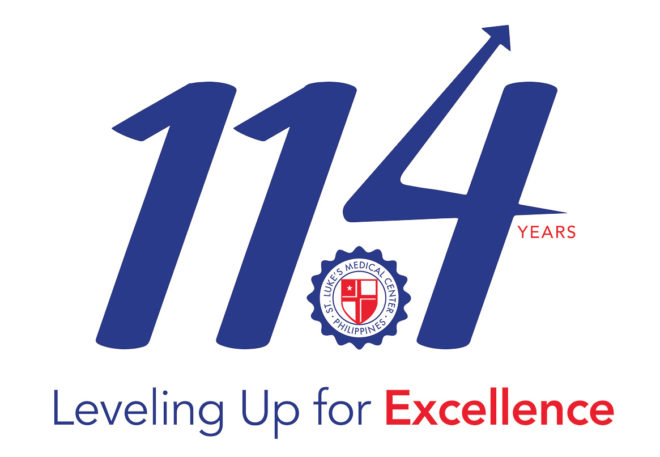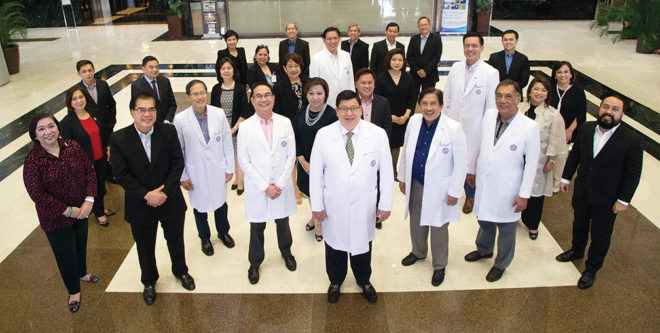St. Luke’s Medical Center marks its 114th anniversary by reflecting on the dramatic changes that have transpired since October 1903 when retired Reverend Charles Henry Brent of the Episcopal Missions set up the Dispensary of St. Luke the Beloved Physician.

A free clinic which served the underprivileged individuals of Calle Magdalena (now Masangkay Street) in Tondo, Manila has since moved to E. Rodriguez Sr. Avenue in Quezon City and expanded its reach as it established a second hospital in Bonifacio Global City. As it plans to redevelop its existing facility in Quezon City, St. Luke’s now even prepares plans for a third one located in Azuela Cove, Lanang, Davao City.
St. Luke’s has continued to position itself at the forefront of innovation, pushing the boundaries of “what ifs” and “why nots” to improve the quality of health care and patient experience in the Philippines.

“I am proud that for 114 years, St. Luke’s has been a model of excellence in patient care and continued to perform advanced and pioneering medical procedures, introduced state-of-the-art equipment, and maintained a brilliant staff of top-notch doctors, compassionate nurses, scientists, support staff, and medical students,” says Dr. Edgardo R. Cortez, President and CEO of St. Luke’s Medical Center.
As other medical institutions in the country work aggressively to also invest in new equipment and expand their facility, Dr. Cortez says St. Luke’s will look further to keep its competitive advantage as a major health care provider throughout the country, providing even safer and more effective medical treatment to patients.
“We aim to influence the standard of healthcare in the country by introducing only superior and leading medical innovations that not only create life-saving treatments, but also boost the name of this institution,” promises Dr. Cortez.
Culture change
He relates that this goal intensified the moment he assumed office in 2012. “The Board proposed a change as they wanted a management style that is something more appropriate for the time. What I suggested was a more open leadership style, consultative and transparent. It was immediately appreciated by the management, the executives and our associates” remembers Dr. Cortez.

As then the hospital’s newly appointed President and CEO, Dr. Cortez remembered telling everyone: “I might have a sense for a lot of things, but I am not an expert of everything, so I will need your help. I will have to consult with you from time to time.”
In terms of getting everyone’s cooperation, Dr. Cortez always reiterates the lines he has told his teachers and more senior colleagues as he was about to lead them as a young chairman of a Department of Surgery in a hospital: “If you believe in our collective dream, then you help me and I will appreciate that. If you are not so convinced yet, then perhaps we can sit down and talk about it. Maybe in the end if you are convinced and wanted to help then you are welcome. However, for those who are not really convinced on our plans and goals—even after we sit down—then I respect your opinion. I only have one request though: do not obstruct, allow us to do our work and judge us in the end.”
Challenges
At the time, Dr. Cortez recalls the challenge of making patients choose St. Luke’s-Global City, which was just two years old. For St. Luke’s-Quezon City, it was how to maintain and further improve a facility that has been in operation since 1961.
“In the face of healthcare’s complexity and highly competitive environment, we had to look for ways to get innovative products or services onto the market,” said Dr. Cortez.
In 2003, St. Luke’s-Quezon City earned the distinction of being the first hospital in the Philippines and the second in Asia to be awarded JCI accreditation in 2003. In 2016, it was accredited by JCI as an Academic Medical Center, also a first in the Philippines. Such accreditation means that the hospital ensures patients the best clinical outcomes and a safe healing environment by adopting international healthcare standards.
In 2012, St. Luke’s-Global City became JCI-accredited after only two years in operation.
“Since then, we have continued getting accreditations from other international regulatory bodies like Temos (Trust. Effective Medicine. Optimized Services), an institution that seeks to improve access to higher quality services for medical travellers, American College of Radiology, which periodically defines new practice guidelines and technical standards for diagnostic and breast imaging, American Association of Blood Banks, an association that accredits DNA paternity testing laboratories worldwide, Investors in People, an organization that sets standard for best practices of people management which incidentally made St. Luke’s the only hospital in the world to receive the Gold accreditation, HACCP (Hazard Analysis Critical Control Point), which sets standards of food safety, and a lot more. Currently, we are in the process of satisfying a set of criteria designed by the American Nurses’ Credentialing Center that would recognize us as a “Magnet Hospital”. This means we are now a healthcare organization recognized for quality patient care, nursing excellence, and innovations in professional nursing practice,” explains Dr. Cortez.
Fulfilling the vision
Most hospitals are primarily focused on treating patients that come through their doors. On the other hand, an academic medical center also does this plus several more. An academic medical center also combines education, training, research, compassionate clinical care, cutting-edge technology, and therapies to achieve the best possible results for its patients.
“Over the past several years, St. Luke’s doctors and scientists have participated in many important discoveries,” says Dr. Isaac David E. Ampil II, St. Luke’s SVP and Head of Research and Biotechnology. In the field of genetic and molecular tests and treatments, Dr. Ampil says the following were achieved by St. Luke’s paving the way for a cheaper, more accurate and reliable results since they were developed using actual Filipino patients.
- First serologic detection test for Dengue in the Philippines, one that is immediate and requiring only a single blood sample to confirm
- First in the country to develop a molecular test for Chikungunya, a dengue-like illness
- First in the country to develop tests for the detection of antibiotic resistance to H. pylori, a bacteria that causes gastritis, peptic ulcer, and cancer
- First in the country to develop genetic testing for Alzheimer’s dementia
- First to conduct ocular stem cell transplant in the country
- First complete genome of bacteria generated by Filipinos
- First in the country to offer complete test package (cytogenetic, FISH and molecular test) for Chronic Myeloid Leukemia
- First in the country to establish the Human Cancer Biobank to study cancer at the genetic and molecular level in order to develop new diagnostics and therapeutics at a “personalized” level
- First in the country to develop a molecular test to detect the aggressiveness of thyroid cancer (Papillary type)
In the field of education and training, St. Luke’s College of Medicine-William H. Quasha Memorial was the first institution in the country to offer a Master of Science Program in Molecular Medicine.
It is interesting to note that St. Luke’s became the first medical center in the country to establish a Center for Human Research Protection, the only one of its kind in the country today that assures the public that the rights, safety, and well-being of human research participants are protected. “We are also developing a point of care diagnostic test to detect dengue that will not require laboratory equipment, and can be used in the field. Additionally, we are looking at biomedical engineering devices that we can use in diagnosing and treating diseases. We are also developing molecular test to detect colon cancer. There are also plans to set up bioequivalence and bioavailability testing center, that will help ensure that herbal and generic drugs used by our countrymen are indeed effective and safe,” enumerates Dr. Ampil.
Academic medical center
Dr. Cortez relates that as St. Luke’s aims to become an internationally recognized academic medical center by 2020, he is proud of several developments happening in recent years.
“Our inclusion in the Mayo Clinic Care Network last October 2016 brought us closer to realizing our vision of becoming an internationally recognized academic medical center. With this collaboration, we can share medical knowledge, have additional access to some of the world’s leading medical experts, and we can leverage this relationship so that these additional resources from Mayo Clinic can be offered to our patients to enhance the care we provide them at no additional cost,” says Dr. Cortez.
Dr. Cortez relates that three years ago, he visited Mayo Clinic to find out what it is doing as a destination hospital in order to benchmark what St. Luke’s can further offer. “There, I met Dr. Elson So who is a Filipino and a Senior Neurologist in Mayo Clinic. We talked about St. Luke’s not really knowing that he will communicate this to the leadership of Mayo Clinic. He came back a few months later with an official invitation for us to be a member. I asked him if we need to apply and he said no. According to him, nobody applies. You have to be invited.”
He relates that Mayo Clinic, after having studied St. Luke’s performance, noting its direction and academic setup, as well as its mission which it found to be very similar, the 153-year-old institution decided to make St. Luke’s its 2nd partner in Southeast Asia and only 4th outside the United States.
“Getting closer to realizing our vision, we also received affiliations with other world leading institutions namely, Johns Hopkins (in redefining the fields of Neurology and Neurosurgery), Massachusetts General Hospital, and Cleveland Clinic (to improve processes for the betterment of our patient care and experience). Going further, the management of St. Luke’s Medical Center also intensify its efforts to publish its researches and see this institution’s influence on international guidelines of treatment. The final test, perhaps, is to be able to influence the way people think about certain diseases or condition, how our basic research, genetic and chromosomal studies, could be translated to the bedside,” says Dr. Cortez.
ADVT









































